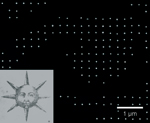IBM's research laboratory in Zurich assembled the golden symbol of the alchemists - printed from 20,000 gold particles with a resolution of 100,000 dots per inch

Scientists at IBM's research laboratories in Zurich have developed a new, precise and efficient printing technology at the scale of nanoparticles. The method may advance the development processes of biological sensors, lenses capable of bending the path of light within optical chips, and enable the production of conductive nanowires, which will form the basis of computer chips in future technological generations.
The IBM scientists for the first time succeeded in printing particles with a size of 60 nanometers - about a hundredth the size of a red blood cell in the human body. The printing is done in a flexible variety of arrays and structures - from straight lines to complex images. If we translate the level of separation (resolution) in this print in terms of dots per inch (dpi), familiar to us from the world of normal printing - then it is a print at 100,000 dots per inch, compared to 1,500 points in normal offset printing.

In order to prove the effectiveness of their printing method, IBM scientists printed the image of the sun by Robert Flood, a 17th century painter, which was used by the alchemists of his generation as a symbol of gold. In this spirit, for the purpose of printing, the researchers used about 20,000 gold particles, each of which is 60 nanometers in diameter, in order to build the smallest image ever printed using only one material.
The standard production methods known today are based on "carving" larger pieces of material, in order to produce nanoparticles from them. Printing, on the other hand, adds pre-prepared particles and places them on the target surface, in an efficient way that also allows the combination of different materials such as metals, polymers, semiconductors or oxides.

The new scientific achievement was revealed in the September issue of the scientific journal Nature Nanotechnology. The availability of the new technology may advance the work and research in a wide variety of fields such as biomedicine, electronics and information technologies, which are looking for ways to utilize the unique capabilities of nano-sized materials: particles smaller than 100 nanometers (tenths of a micron).
The world of biomedicine may take advantage of the new technology in order to print a large amount of sensors capable of identifying different types of cells or biological markers, for the purpose of rapid diagnosis of diseases from extremely small cell samples.
Nanoparticles can also act in combination with light. The new production method based on the technology developed at IBM may enable the printing of optical materials with new capabilities, and their use in opto-electronic components. Thus, it is possible to print even small structures with dimensions even greater than a given wavelength - and use the printed component as a single lens for everything.
The world of microelectronics also enjoys new promise with the availability of such a printing process. In one of the experiments, the researchers were able to place in a controlled manner particles that make it possible to grow in the process of growing crystals nano-wiring, which may form the basis for transistors and microchips.
Compared to traditional printing processes, in which ink is spread over a grooved surface, nano printing is carried out in IBM's process by collecting and organizing particles on the printing template - and transferring them from there to the target surface, with a precision and separation that is three orders of magnitude higher than that of normal printing.
IBM's researchers have successfully tested printing options for extremely dense conductive lines, which may be used in the world of molecular electronics, printing particles at regular intervals which may serve as an infrastructure for growing crystals and transistors, and complex structures such as the image of the sun. In the next phase, the research is expected to focus on improving the process in order to produce even higher levels of precision, such as those that will be required in combination with microelectronics, and printing even smaller particles.

3 תגובות
I can't believe I just read two comments like that. What is this, a joke? And I know I'm rude, but you too think before you write...
This is not true at all
Nanotechnology can cause such and other problems
But no longer exist
In small particles a nano particle has no effect even at a high concentration than its submission to the mass of matter in nature
In larger materials there is no problem anyway because of the size
Besides that there is no basic natural substance that can cause harm to the body even in its maximum concentration
Of course, if someone planned a virus or a disease of one kind or another, it cannot be prevented, but there are solutions for this that will be invented in the near future
In any case, such and such gifs will be no less than a micron
And they do not penetrate the body
They can harm the lungs - it is inevitable that such and such diseases and such and such viruses are currently serious problems in the human body
Nanotechnology is not the problem, it's just another brain fog
Nano technology may create a serious and very difficult to cure infection that will cause diseases in the lungs, digestive system and more.